Rivera Sun's Blog: From the Desk of Rivera Sun, page 25
September 7, 2016
Know Your Nonviolent History: Fannie Lou Hamer
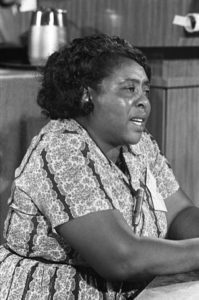
Photo Credit: By Warren K. Leffler, U.S. News & World Report Magazine; Restored by Adam Cuerden – Public Domain
This story appeared as part of Pace e Bene/Campaign Nonviolence‘s inspirational email service: This Nonviolent Life. Sign up here.
Civil Rights activist Fannie Lou Hamer was born on October 6th, 1917, in Mississippi, and lived under the harsh reality of the Jim Crow South. Through years of courage and challenge, she became a legendary figure within the Civil Rights Movement.
“Sometimes,” she said, “it seems like to tell the truth today is to run the risk of being killed. But if I fall, I’ll fall five feet four inches forward in the fight for freedom. I’m not backing off.”
On August 23, 1962, Rev. James Bevel, an organizer for Student Nonviolent Coordinating Committee (SNCC) gave a sermon in Ruleville, MI, and issued an appeal to those gathered to register to vote. Despite the very real threat of lynching, beating, and job loss, Hamer was the first to volunteer. She later said, “I guess if I’d had any sense, I’d have been a little scared — but what was the point of being scared? The only thing they could do was kill me, and it kinda seemed like they’d been trying to do that a little bit at a time since I could remember.”
On August 31, she traveled with others to register to vote, singing hymns to bolster their confidence. When she returned home, she was fired from her recordkeeping and accounting job at the plantation where she worked. Fortunately, SNCC organizer Bob Moses had already tasked people to “find the lady who sings the hymns”. By the early part of 1963, SNCC hired her as a field secretary. Fannie Lou Hamer began traveling the South, organizing people to vote.
On June 9th, after one such trip, she was arrested along with other organizers, taken to jail, and beaten with a police blackjack by a pair of prisoners who had been ordered by the white guards to beat her within an inch of her life. It took Hamer more than a month to recover, and she suffered lifelong health challenges due to this event.
In 1964, the Mississippi Freedom Democratic Party decided to send a delegation to challenge the state’s all-white and anti-civil rights delegation to the Democratic National Convention. Hamer was elected Vice-Chair. On the night she was to speak on national television about the injustice they faced, President Johnson called an impromptu press conference to co-opt her airtime and silence her. Her speech was recorded, however, and aired later that evening. The Mississippi Freedom Democrats made progress, but success would not come for another four years, when the DNC finally passed a clause requiring equality of representation from the delegate groups. In 1972, Hamer was elected as a national party delegate.
Fannie Lou Hamer’s work extended far and wide, including powerful anti-poverty and self-reliance programs for local communities in Mississippi, never losing sight of the connections between education, jobs, and political influence. She died in 1977 and hundreds of people attended her funeral. A memorial service nearby drew 1500 people wishing to pay their respects. Her tombstone is engraved with one of her favorite sayings, “I am sick and tired of being sick and tired.”
Learn more about Fannie Lou Hamer here.
______________
A uthor/Activist Rivera Sun, syndicated by PeaceVoice, is the author of The Dandelion Insurrection, Billionaire Buddha and Steam Drills, Treadmills, and Shooting Stars, the cohost of Love (and Revolution) Radio, and the co-initiator of Live Share Grow: A Movement for the 100%. She is a trainer and social media coordinator for Campaign Nonviolence and Pace e Bene. Sun attended the James Lawson Institute on Strategic Nonviolent Resistance in 2014 and her essays on social justice movements appear in Counterpunch, Truthout and Popular Resistance. www.riverasun.com
uthor/Activist Rivera Sun, syndicated by PeaceVoice, is the author of The Dandelion Insurrection, Billionaire Buddha and Steam Drills, Treadmills, and Shooting Stars, the cohost of Love (and Revolution) Radio, and the co-initiator of Live Share Grow: A Movement for the 100%. She is a trainer and social media coordinator for Campaign Nonviolence and Pace e Bene. Sun attended the James Lawson Institute on Strategic Nonviolent Resistance in 2014 and her essays on social justice movements appear in Counterpunch, Truthout and Popular Resistance. www.riverasun.com
Thrown Under the Automated Bus
 Automation isn’t coming. It’s here. At the airport, the public library, the grocery store, and dozens of other places, touch screens are rapidly replacing human bodies, especially in basic service industry positions. In a time when service industry jobs represent 80 percent of all employment in the United States, and when a presidential report on automation looks at the frightening possibility of more than half the jobs in the country being lost, one could reasonably expect the current presidential and congressional candidates to be putting forth bold strategies for addressing the rising economic crisis and skyrocketing unemployment rates for middle and working class families.
Automation isn’t coming. It’s here. At the airport, the public library, the grocery store, and dozens of other places, touch screens are rapidly replacing human bodies, especially in basic service industry positions. In a time when service industry jobs represent 80 percent of all employment in the United States, and when a presidential report on automation looks at the frightening possibility of more than half the jobs in the country being lost, one could reasonably expect the current presidential and congressional candidates to be putting forth bold strategies for addressing the rising economic crisis and skyrocketing unemployment rates for middle and working class families.
We can praise the timesaving efficiency of automation, but we must also deal with the unintended consequences. The potential of automation comes with a shadow side, which must be rigorously discussed and addressed in our nation and around the world.
People will be replaced by machines. Profits for the already wealthy will soar. Millions of Americans will be left without jobs. At this point, our nation has no comprehensive transition plan. There is marginal lip service being paid to “retraining programs” and “jobs fairs,” but the scale of these proposals is like trying to plug Niagara Falls with a toothpick. Business journals tout the creation of new jobs in automation design and maintenance, but it is uncertain as to how many jobs will be created, and for how long. The shift into automation requires not reckless enthusiasm, but rather, proactive planning from both the business and political sectors.
We are told that the economy has recovered from the 2008 crash. The average American feels the daily pinch of the truth: we have seen no recovery. Ninety-five percent of the income gains went straight into the pockets of the One Percent. The rest of us are still swamped with debt, struggling desperately to pay bills, and at risk of financial catastrophe caused by unexpected expenses no larger than a failing car engine or a broken bone. We have no economic safety nets or savings to fall back on.
The elections loom large on the horizon of our nation. The circus of the presidential race overshadows the congressional races – but it is the make-up of the legislature that will – or will not – place a wide variety of economic policies on the political table. Bills about widening the social safety net, implementing basic income, taxing the rich, closing loopholes that benefit mega-corporations and the super-wealthy, addressing student debt, stopping unfair corporate trade deals, and raising the minimum wage to a living wage must be considered. It is the make-up of the legislature that will determine whether or not an adequate response to the economic upheaval of rising automation will be proposed, debated, and passed.
We have been brought to the brink of an unsuspected revolution, arriving full circle to a parallel moment in history to the Industrial Revolution. Widespread automation demands that we once again engage in a global and national moral debate about both the meaning of work and the purpose of the economy. Is the purpose of our economy merely to provide profits for a few people or is our economy meant to care for the populace and provide for everyone’s needs?
With the mechanization of the Industrial Revolution, humanity was asked to grapple a seemingly simple question: what do we do with the free time provided by the efficiency of machines? Then, like today, the ruling elite was politically poised to answer the question with a solution that was highly profitable for them: work harder, produce more, make more money for us.
This time, the nature of the question has expanded. Does the ruling elite (the owning class – the rich people) have a moral and social responsibility to provide for the needs of the people while their businesses automate and cause widespread unemployment?
It is a political question, and an ethical, moral, and social question. What is the responsibility of the rich and powerful toward the rest of us? Are we – the workers, inventors, artists, teachers, mothers and fathers and children – merely convenient sources of ultimately disposable labor to them? Should corporations, owners, and the current crop of corporate politicians be allowed to throw us out when machines become more profitable than our bodies? What will they do when unemployment skyrockets, families can’t pay rents or mortgages, homelessness becomes endemic, and the United States consumer class vanishes? What actions will these political candidates take . . . will they simply pocket the profits of automation and start selling goods to China? Or will they demonstrate that they have the political backbone to do what’s right for the people and address the systemic crisis that has arrived on our doorstep?
We are on the verge of being thrown under the automated bus. Make your choices carefully this November; this election cycle determines what measures the next crop of politicians will take to keep us all from being run over.
___________
A uthor/Activist Rivera Sun, syndicated by PeaceVoice, is the author of The Dandelion Insurrection, Billionaire Buddha and Steam Drills, Treadmills, and Shooting Stars, the cohost of Love (and Revolution) Radio, and the co-initiator of Live Share Grow: A Movement for the 100%. She is a trainer and social media coordinator for Campaign Nonviolence and Pace e Bene. Sun attended the James Lawson Institute on Strategic Nonviolent Resistance in 2014 and her essays on social justice movements appear in Counterpunch, Truthout and Popular Resistance. www.riverasun.com
uthor/Activist Rivera Sun, syndicated by PeaceVoice, is the author of The Dandelion Insurrection, Billionaire Buddha and Steam Drills, Treadmills, and Shooting Stars, the cohost of Love (and Revolution) Radio, and the co-initiator of Live Share Grow: A Movement for the 100%. She is a trainer and social media coordinator for Campaign Nonviolence and Pace e Bene. Sun attended the James Lawson Institute on Strategic Nonviolent Resistance in 2014 and her essays on social justice movements appear in Counterpunch, Truthout and Popular Resistance. www.riverasun.com
September 4, 2016
Life In Rebellion to the Corporate State
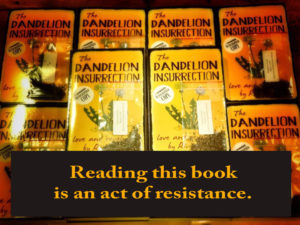 From Author Rivera Sun: If I ever wrote a sequel to The Dandelion Insurrection (and if any angels are reading this who want to offer a year’s advance and a publishing deal, let’s talk), this musing I wrote this morning might appear in the book somewhere.
From Author Rivera Sun: If I ever wrote a sequel to The Dandelion Insurrection (and if any angels are reading this who want to offer a year’s advance and a publishing deal, let’s talk), this musing I wrote this morning might appear in the book somewhere.
At a certain point, you realize you must live in utter rebellion to the totalitarian oligarchic-corporate state that controls our government, legal system, police and military, the media, education, entertainment, arts and culture. You start to make daily acts of resistance to their domination of so many aspects of our world.
You don’t watch their movies or read their books or magazines. You reject their values of profit and greed, and their ideologies of “survival of the fittest” and “might makes right” and “what’s good for business is good for everyone”. You lift your middle finger to the box stores and go out of your way to support small and local businesses. You become allergic to name brands. You don’t go shopping on the national holidays coopted by their marketing schemes. You start to say things like, “there’s more to life than being a consumer”.
You live a life of quiet (or bold) rebellion, feeling at odds with their dominant culture, wondering just how long it will be before your fellow human beings realize they’re being treated like peons or cattle in this massive oligarchic-corporate system. You watch cynical and distant as yet another person spends his or her life working for corporate overlords, buying from corporate overlords, subscribing to their mass-marketing indoctrination of beliefs, obeying the laws they buy from their lapdog politicians, and even dying slowly for them as they milk your body and lifeblood for profit in their horrific corporatized so-called healthcare system where they literally squeeze you for every last penny and breath of life you’ve got.
It’s a bizarre experience, living in rebellion to a corporatized culture while nearly everyone else blindly obeys and conforms. You’re constantly standing to the side of your friends and neighbors, wondering what the hell they’re doing. You want to shake people, scream, search desperately for the words to articulate the living hell they call normal.
Aloneness strikes up an enduring friendship as you wonder just how long it will take for humanity to rise up for its own heart and soul. You wonder if you will see change happen in your lifetime, or whether you will close these eyes on the world without seeing humanity shake off the shackles of corporate domination of their culture, thoughts, beliefs, activities, recreation, life, and values.
And you search for other rebels. You look for people in the margins and eddies of the world, carving out niches beyond the corporations’ control, building oasis of real people, real food, real heart and hope. You embark on expeditions to find them. You pilgrimage to places and communities where they have come together to build a different way of life. You learn their songs and dances. Then you go back into the belly of the beast, singing to those who will listen.
____________
A uthor/Activist Rivera Sun, syndicated by PeaceVoice, is the author of The Dandelion Insurrection, Billionaire Buddha and Steam Drills, Treadmills, and Shooting Stars, the cohost of Love (and Revolution) Radio, and the co-initiator of Live Share Grow: A Movement for the 100%. She is a trainer and social media coordinator for Campaign Nonviolence and Pace e Bene. Sun attended the James Lawson Institute on Strategic Nonviolent Resistance in 2014 and her essays on social justice movements appear in Counterpunch, Truthout and Popular Resistance. www.riverasun.com
uthor/Activist Rivera Sun, syndicated by PeaceVoice, is the author of The Dandelion Insurrection, Billionaire Buddha and Steam Drills, Treadmills, and Shooting Stars, the cohost of Love (and Revolution) Radio, and the co-initiator of Live Share Grow: A Movement for the 100%. She is a trainer and social media coordinator for Campaign Nonviolence and Pace e Bene. Sun attended the James Lawson Institute on Strategic Nonviolent Resistance in 2014 and her essays on social justice movements appear in Counterpunch, Truthout and Popular Resistance. www.riverasun.com
August 31, 2016
Know Your Nonviolent History: Community of Peace People
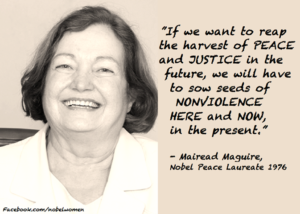 This story appeared as part of Pace e Bene/Campaign Nonviolence‘s inspirational email service: This Nonviolent Life. Sign up here.
This story appeared as part of Pace e Bene/Campaign Nonviolence‘s inspirational email service: This Nonviolent Life. Sign up here.
On August 10th, 1976, Anne Maguire took her children out to go shopping in Northern Ireland. Anne was pushing a pram with her six-week-old newborn. Her son walked ahead; her daughter rode her bicycle beside her, and her toddler trotted along at her side.
A car hurtled down the street carrying IRA fugitives, one dead, another critically wounded, with the British police chasing after them. The car spun out of control, leapt the curb, and slammed into Anne and her children. The youngest three died immediately, and Anne was severely injured.
It was the time of the Troubles, when escalating violent conflict between Irish Catholics and Protestants had led to bombings, gun violence, and conflict between paramilitary and military forces. More than 3,500 people were killed in the conflict, of whom 52% were civilians, 32% were members of the British security forces, and 16% were members of paramilitary groups. Although the context of the conflict had many centuries-old historical roots, the Troubles began in the 1960s and lasted until the Good Friday Agreement in 1998, with a sharp decline in violence after 1978 due to the efforts of the Community of Peace People that was initiated in the wake of the children’s deaths.
A shrine grew at the site of the car crash. The violence and the deaths seemed senseless. Who was to blame? Both sides of the conflict had a role in the tragedy. Neighbors held a prayer walk through the area, the chapels were packed with vigils, women canvassed door-to-door calling for an end to the violence. All over Northern Ireland, protests against the violence were being organized. Mairead Corrigan Maguire, Anne’s sister, arrived, and heard about how one neighbor, Betty Williams, had told reporters and anyone who needed questions answered to contact her. Mairead connected with Betty, and then went down to the television station and asked for airtime to call for an end to the violence.
In Belfast and Dublin, 60,000 citizens joined the demonstrations organized by the newly formed Community of Peace People, founded by Betty Williams and Mairead Corrigan Maguire. Within six months, there was a 70% drop in the rate of violence. Along with rallies and demonstrations for peace, the Peace People structured an ongoing movement to deal with the root causes of the conflict. They campaigned for nonviolence, justice, and equality.
The process was difficult, challenging, but the conflict reached an uneasy accord twenty years later with the “Good Friday Agreement of 1998”. Wikipedia reports, “The Troubles were brought to an uneasy end by a peace process that included the declaration of ceasefires by most paramilitary organizations, the complete decommissioning of the IRA’s weapons, the reform of the police, and the corresponding withdrawal of the British Army from the streets and sensitive Irish border areas such as South Armagh and Fermanagh, as agreed by the signatories to the Belfast Agreement (commonly known as the “Good Friday Agreement”).”
Over 100,000 people (out of a total population of roughly three million) participated in the Peace People movement, and Betty Williams and Mairead Corrigan Maguire received the Nobel Peace Prize for their work. Their story is yet another example of the power of active nonviolence working toward peace in difficult, challenging, and entrenched situations. The perseverance and vision of both the founders of the movement and the participants can be sensed here, in the words of the Declaration of the Peace People:
“ . . . We want to live and love and build a just and peaceful society. We want for our children, as we want for ourselves, our lives at home, at work and at play, to be lives of joy and peace.
We recognize that to build such a life demands of all of us, dedication, hard work and courage. . . .We dedicate ourselves to working with our neighbors, near and far, day in and day out, to building that peaceful society in which the tragedies we have known are a bad memory and a continuing warning.”
Learn more here: http://www.peacepeople.com/
____________
A uthor/Activist Rivera Sun, syndicated by PeaceVoice, is the author of The Dandelion Insurrection, Billionaire Buddha and Steam Drills, Treadmills, and Shooting Stars, the cohost of Love (and Revolution) Radio, and the cofounder of the Love-In-Action Network. She is a trainer and social media coordinator for Campaign Nonviolence and Pace e Bene. Sun attended the James Lawson Institute on Strategic Nonviolent Resistance in 2014 and her essays on social justice movements appear in Truthout and Popular Resistance. www.riverasun.com
uthor/Activist Rivera Sun, syndicated by PeaceVoice, is the author of The Dandelion Insurrection, Billionaire Buddha and Steam Drills, Treadmills, and Shooting Stars, the cohost of Love (and Revolution) Radio, and the cofounder of the Love-In-Action Network. She is a trainer and social media coordinator for Campaign Nonviolence and Pace e Bene. Sun attended the James Lawson Institute on Strategic Nonviolent Resistance in 2014 and her essays on social justice movements appear in Truthout and Popular Resistance. www.riverasun.com
August 25, 2016
The Sane Candidate: Which Representatives Will End the Endless Wars?
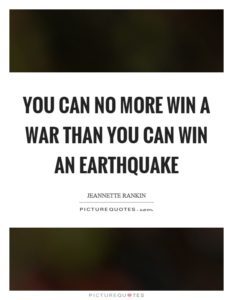 “You can no more win a war than you can win an earthquake,” said Jeannette Rankin, the first woman elected to Congress.
“You can no more win a war than you can win an earthquake,” said Jeannette Rankin, the first woman elected to Congress.
Decades of invasions, airstrikes, occupations, and conflict have left Americans staring at a disastrous rubble of our own making. War is an earthquake – a violent, destructive force unleashed. The aftershocks bring our veterans and communities to their knees as 20 veterans commit suicide each day, and PTSD cripples veterans and their families. Our tax dollars are sucked into the bottomless pit of military contractors’ pockets and we witness greedy oligarchs and politicians manipulating the nation into yet another war while the unhealed scars and wounds from past conflicts grow increasingly deeper.
The annual cycle of military holidays sets off flurries of sentimental speeches about supporting our troops. But, between the bouts of patriotic fanfare, few politicians care enough about those women and men in uniform to end the wars and bring them home, to de-escalate growing conflicts, or to demonstrate real commitment to dealing with the veterans with respect by providing adequate services, preventing homelessness, and treating PTSD and other health challenges.
In this election cycle, the citizens – left and right – need to question the militarized rhetoric of the candidates. Who is campaigning on “bringing American sons and daughters home?” Which candidates want to end wars? Who dares to stand up to the greed of the military industrial complex and call out warmongers who are just hungry for a new multibillion-dollar military contract? Which candidates will defy the profiteering racket that takes our nation’s youth and sends them into the jaws of death in order to rake in trillions of our tax dollars that should have been spent on education and infrastructure—both of which produce far more good jobs per $billion spent than the military sector?
Who challenges inflammatory lies that drive us into conflicts around the globe? Who will publicly say that hate speech is endangering – not saving – our young people? Our men and women in the military know firsthand the vast difference between the lies and propaganda we are told versus the realities on the ground in the countries our troops are fighting in.
Which candidates will decry the rising militarism of our society, and especially in our police? Many of our veterans are deeply disturbed by these trends. For them, militarized police are a violation of the ethics they were taught. To view citizens as “potential enemy combatants” – as many police trainings currently teach – is an affront to the deep principles of loyalty and protection they believe in. Seeing tanks and assault rifles on the streets at home triggers PTSD, invokes the horrors of what they experienced, and makes them wonder what were they fighting for if war is now a reality in our streets, waged by our own police forces against our own citizens. The very freedoms they were trained to defend are constantly being violated by the actions of the police – as well as by the NSA, by legislation passed by politicians, and by the failure of corporate-controlled courts to uphold the rights of citizens.
This election cycle, pay attention to which candidates speak about ending wars, not escalating them and about smarter ways to ensure our security. Who stands up for the rights of all citizens, equally? Congressional seats are up in the air this election cycle. Beyond the presidential race, who embodies the values we wish to see put into legislation in our nation? These are the questions we need to ask as we rapidly approach Election Day. These are the questions that determine whether politicians will continue to send our young men and women into endless wars . . . or whether politicians will find the backbone to honor our troops by respecting – and radically reducing – the role militarism is expected to play within the broader context of our nation.
_______________
A uthor/Activist Rivera Sun, syndicated by PeaceVoice, is the author of The Dandelion Insurrection, Billionaire Buddha and Steam Drills, Treadmills, and Shooting Stars, the cohost of Love (and Revolution) Radio, and the cofounder of the Love-In-Action Network. She is a trainer and social media coordinator for Campaign Nonviolence and Pace e Bene. Sun attended the James Lawson Institute on Strategic Nonviolent Resistance in 2014 and launched Live Share Grow: A Movement for the 100% in 2016. Her essays on social justice movements appear in Counterpunch, Truthout, Popular Resistance and other online journals. www.riverasun.com
uthor/Activist Rivera Sun, syndicated by PeaceVoice, is the author of The Dandelion Insurrection, Billionaire Buddha and Steam Drills, Treadmills, and Shooting Stars, the cohost of Love (and Revolution) Radio, and the cofounder of the Love-In-Action Network. She is a trainer and social media coordinator for Campaign Nonviolence and Pace e Bene. Sun attended the James Lawson Institute on Strategic Nonviolent Resistance in 2014 and launched Live Share Grow: A Movement for the 100% in 2016. Her essays on social justice movements appear in Counterpunch, Truthout, Popular Resistance and other online journals. www.riverasun.com
August 24, 2016
Accountability: An Abandoned American Value

CCO Public Domain
If our cars fatally malfunctioned as often as police officers shoot citizens, there would be a massive recall, pulling vehicles off the road, overhauling the engineering design, firing culpable employees, and paying out settlements to consumers for injuries and deaths of family members.
The problem of a complete lack of accountability within the police system parallels the demise of accountability throughout our nation. Once upon a time, we believed in accountability. But times have changed, and wanton, reckless irresponsibility has become permissible for police officers, corporations, politicians, and the wealthy. If you are a wealthy politician or businessman, the law rarely applies to you. If you are a Wall Street banker, you receive bailouts instead of criminal charges. If you own an oil company, you receive mild wrist slaps for causing catastrophic environmental disasters. If you’re in the military, you operate with unscrutinized impunity and negotiated immunity. If you’re a white rapist, you cool your heels for a while before diving back into the pool. If you’re a white killer who opens fire on African Americans in a House of God, you get a hamburger on the way to jail.
If you are poor or non-white, you are slapped with life sentences, death sentences, extrajudicial murders, public lynching, debt peonage, debilitating poverty, foreclosures, homelessness, poisoned water, strangulations, forced sterilization, home raids by SWAT teams . . . and the list goes on.
In this upside-down world, the poor, the young, the homeless, the old, and minority groups bear the deadly cross of accountability for the wanton irresponsibility of the U.S. corporations, politicians, wealthy, and privileged. It is they who are incarcerated, poisoned, executed, and chained to debt. It is they who lose their homes, jobs, bank accounts, safety, health, social networks, societal respect, and are stripped of titles, positions, dignity, rights, and awards. The poor and downtrodden are held accountable for the wrongs of the society – they pay the price for U.S. violence, greed, corruption, pollution, destruction, hate, discrimination, and arrogance. Whistleblowers who demand accountability for atrocities and the egregious violations of our rights are imprisoned and exiled while those that perpetrated the crimes remain in power.
This election season, we are chided to vote and “hold our policy makers” accountable – as if this were the only means of doing so. Where is our judicial system, our oversight committees, or the straightforward enforcement of existing laws? In 240 years, the United States has failed to generate and enforce a practical and effective system of political and corporate accountability. Where are our citizen oversight committees with the power to subpoena and charge police departments? Where is our version of Spain’s Partido X and its accompanying standards of political accountability? Where are our lawyers and judges will to prosecute and sentence reckless bankers as was done in Iceland after the financial crash?
Accountability for one’s actions is a value that functional societies require at every level from our children to our corporations to our Commanders-in-Chief. Without such a standard, the moral compass of our nation spins out of control, wildly sending us into dangerous and uncharted waters of increasingly rogue and criminal behaviors. When will the American public finally see accountability from all its power holders? The answer is: only when we demand it.
_________________
A uthor/Activist Rivera Sun, syndicated by PeaceVoice, is the author of The Dandelion Insurrection, Billionaire Buddha and Steam Drills, Treadmills, and Shooting Stars, the cohost of Love (and Revolution) Radio, and the cofounder of the Love-In-Action Network. She is a trainer and social media coordinator for Campaign Nonviolence and Pace e Bene. Sun attended the James Lawson Institute on Strategic Nonviolent Resistance in 2014 and her essays on social justice movements appear in Truthout and Popular Resistance. www.riverasun.com
uthor/Activist Rivera Sun, syndicated by PeaceVoice, is the author of The Dandelion Insurrection, Billionaire Buddha and Steam Drills, Treadmills, and Shooting Stars, the cohost of Love (and Revolution) Radio, and the cofounder of the Love-In-Action Network. She is a trainer and social media coordinator for Campaign Nonviolence and Pace e Bene. Sun attended the James Lawson Institute on Strategic Nonviolent Resistance in 2014 and her essays on social justice movements appear in Truthout and Popular Resistance. www.riverasun.com
Know Your Nonviolent History: The Baltic Way
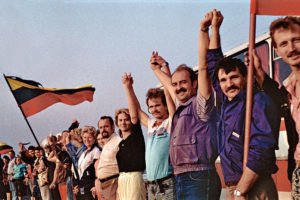
Photo Credit: By Kusurija – Own work, CC BY-SA 3.0
This story appeared as part of Pace e Bene/Campaign Nonviolence‘s inspirational email service: This Nonviolent Life. Sign up here.
On August 23rd, 1989, two million people joined hands to form a human chain crossing the three Baltic states of Estonia, Latvia, and Lithuania, in protest against the Soviet Union, and in support of each nation’s independence. The Baltic Way, as the human chain was called, spanned 420 miles, engaging people of all ages in this historic demonstration.
The organizers spent countless hours putting the demonstration together. They designative specific locations and groups of people to go to each of the cities, towns, and villages to ensure the chain would not have any gaps. Free bus service was provided. Preparations engaged the rural population who had been generally left out of the more urban-based resistance actions. Some employers sponsored the bus rides. Estonia declared a public holiday.
On the day of the event, special radio broadcasts helped to coordinate the effort. The human chain was photographed from land and air, and screened on televisions in many countries. Remarkably, within three years, all of the Baltic states had achieved independence from the Soviet Union, starting with Lithuania a mere seven months after the Baltic Way demonstration.
All three states achieved their independence through nonviolent action, using a wide range of methods including demonstrations, rallies, cultural resistance, occupations, strikes, boycotts, blockades, and, famously in Estonia’s case, singing.
To this day, the Baltic states maintain a high level of engagement with nonviolent struggle. The three countries have a joint accord to support one another through nonviolent action – just as many other nations have such accords for military support. Lithuania has been a pioneer in civilian based defense, which utilizes nonviolent civil resistance to prevent and thwart foreign invasions, occupations, and coups. The Lithuanian Defense Minister even issued a pamphlet to the citizens to train them in nonviolent civilian-based defense!
The example of these three tiny nations is an inspiring one . . . many countries, including our own, would do well to emulate the commitment to nonviolent action embodied in the Baltic Way.
Learn more: https://en.wikipedia.org/wiki/Baltic_Way
____________
A uthor/Activist Rivera Sun, syndicated by PeaceVoice, is the author of The Dandelion Insurrection, Billionaire Buddha and Steam Drills, Treadmills, and Shooting Stars, the cohost of Love (and Revolution) Radio, and the cofounder of the Love-In-Action Network. She is a trainer and social media coordinator for Campaign Nonviolence and Pace e Bene. Sun attended the James Lawson Institute on Strategic Nonviolent Resistance in 2014 and her essays on social justice movements appear in Truthout and Popular Resistance. www.riverasun.com
uthor/Activist Rivera Sun, syndicated by PeaceVoice, is the author of The Dandelion Insurrection, Billionaire Buddha and Steam Drills, Treadmills, and Shooting Stars, the cohost of Love (and Revolution) Radio, and the cofounder of the Love-In-Action Network. She is a trainer and social media coordinator for Campaign Nonviolence and Pace e Bene. Sun attended the James Lawson Institute on Strategic Nonviolent Resistance in 2014 and her essays on social justice movements appear in Truthout and Popular Resistance. www.riverasun.com
August 17, 2016
Know Your Nonviolent History: In 1976 Clamshell Alliance Launches Mass Demonstrations
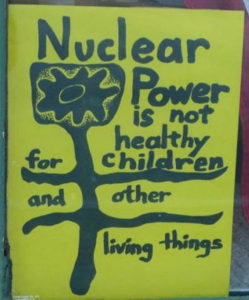
Anti-nuclear poster from the 1970s American movement
On August 1st, 1976, the first nonviolent mass demonstration of the Clamshell Alliance took place at the proposed site of the Seabrook Nuclear Energy Facility in New Hampshire. The Clamshell Alliance was a group of anti-nuclear activists who worked to stop nuclear power plant construction at a time when President Nixon’s “Project Independence” had proposed the construction of over 1,000 nuclear power plants throughout the nation. Although the Clamshell Alliance was only partially successful in halting the Seabrook facility, their mass mobilizations deterred the plans for other plants and changed the landscape of nuclear energy forever. If not for the Clamshell Alliance, it is possible that we would be living in the nuclear nightmare of President Nixon’s vision of a thousand plants by the year 2000.
The Clamshell Alliance used a model of affinity groups of 6-20 people, and a spokes council system that functioned on consensus decision-making by all members. In July 1976, the Clamshell Alliance adopted a Declaration of Nuclear Resistance and by August 1st had mobilized their first protest of 200-600 people. Later in August, a second protest and civil disobedience action occupied the Seabrook construction site for 75 minutes, singing songs and planting trees. Nearly all of the 200 participants were arrested.
In April of 1977, the Clamshell Alliance mobilized 2,000 people for a demonstration. 1,400 participants were arrested, most refusing to post bail. They were held in jails and National Guard armories for up to two weeks. The activists used this time for training and networking, and subsequently, the detention of the activists was seen as a blunder on the part of Governor Meldrim Thomson.
In 1978, the Clamshell Alliance successfully organized another series of mass demonstrations and arrests. From June 23-26th, the alliance accepted an agreement to legally protest on the site for three days. Some sources claim this protest was one of the largest on-site protests in the history of the anti-nuclear movement, citing over 20,000 participants and very few arrests.
On March 29th, 1979, the meltdown of the Three Mile Island reactor in Harrisburg, Pennsylvania, propelled the dangers of nuclear power to the forefront of national concern. In collaboration with other groups, a huge anti-nuclear energy rally was organized in Washington, D.C. on May 6, 1979. Between 50,000 and 120,000 people gathered to protest nuclear power and demand safe alternatives.
These demonstrations played a major role in slowing and stopping the rush toward nuclear energy. Although Unit 1 of Seabrook Power Plant went online in 1990, Unit 2 was cancelled altogether. The project cost seven times the original billion-dollar estimate and was completed 14 years later than anticipated. In that time, hundreds of other proposals were dropped, due to the high social and fiscal costs encountered by the Seabrook Power Plant. For decades after the inception of the Clamshell Alliance and other similar groups, no new nuclear power facilities were proposed or constructed. The Clamshell Alliance left a lasting legacy in its organizing structure, movement practices, consensus model, and strategies for change. These are all tools and resources that can be used by current movements for change.
http://www.clamshellalliance.net/about/
https://en.wikipedia.org/wiki/Clamshell_Alliance
____________
A uthor/Activist Rivera Sun, syndicated by PeaceVoice, is the author of The Dandelion Insurrection, Billionaire Buddha and Steam Drills, Treadmills, and Shooting Stars, the cohost of Love (and Revolution) Radio, and the cofounder of the Love-In-Action Network. She is a trainer and social media coordinator for Campaign Nonviolence and Pace e Bene. Sun attended the James Lawson Institute on Strategic Nonviolent Resistance in 2014 and her essays on social justice movements appear in Truthout and Popular Resistance. www.riverasun.com
uthor/Activist Rivera Sun, syndicated by PeaceVoice, is the author of The Dandelion Insurrection, Billionaire Buddha and Steam Drills, Treadmills, and Shooting Stars, the cohost of Love (and Revolution) Radio, and the cofounder of the Love-In-Action Network. She is a trainer and social media coordinator for Campaign Nonviolence and Pace e Bene. Sun attended the James Lawson Institute on Strategic Nonviolent Resistance in 2014 and her essays on social justice movements appear in Truthout and Popular Resistance. www.riverasun.com
Know Your Nonviolent History: Love Canal
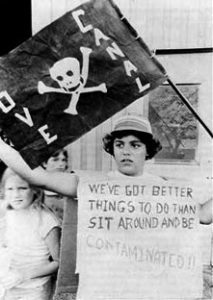
Photo Credit: A protest by Love Canal residents, ca. 1978. Public Domain
This week in nonviolent history commemorates a turning point in the long struggle to demand justice for the residents of Love Canal, a residential community in upstate New York that was situated on top of a leaking toxic waste dump. On August 2nd, 1978, State Health Commissioner Robert Whalen issued a state of emergency ordering the immediate closure of the nearby 99th Street School (where children played in puddles of leaking toxins) and the evacuation and relocation some of the residents. Two years later, after serious campaigning by the remainder of the residents, President Jimmy Carter issued a National Emergency, which relocated the rest of the residents. Love Canal remains a super-fund site to this day.
The story begins in the 1890s, when developer William T. Love planned to dig a canal between the Niagara River and Lake Erie, and situate a “dream community” named Model City along it. Love dug about a mile of the canal, built a few houses and streets along it, and then the financial crash of 1893 dashed his dreams. In the early days, the children in the area used to swim in the river in the summer, and skate on it in the winter, but in the 1920s, the Niagara Municipal Department began to use the pit for dumping refuse. In the 1940s, Hooker Chemical used Love Canal for their toxic wastes.
In 1952, Hooker Chemical deeded the site to the Niagara Falls School Board for a dollar. In the “sales” agreement, Hooker Chemical included a seventeen-line section releasing them from all legal obligations. The Niagara Falls School Board signed, and began to develop the site for a school. During construction, the containment walls were breached, and toxins began to seep out. In 1955, a twenty-five foot area crumbled, exposing toxic chemical drums, which then filled with water during rainstorms. A few years later, low-income and single unit dwellings were built, breaching more of the containment walls.
By 1978, around 800 single-family homes and 240 low-income apartments had been built, and reporter Michael Brown described Love Canal as a “public health time bomb”. His door-to-door investigations discovered frequent cases of birth defects and many anomalies such as enlarged feet, heads, hands, and legs. On his advice, local residents created a protest group, led by resident Karen Schroeder, whose daughter had nearly a dozen birth defects. Michael Brown’s journalism also alerted Lois Brown, who had moved to Love Canal, enrolled her son in the elementary school in September 1977, and by December, found her son seriously ill, having developed epilepsy, asthma, a urinary tract infection, and had a low white blood cell count – all symptoms that were eventually proven to be associated with his exposure to the leaking chemical waste.
Wikipedia reports, “Gibbs began speaking with her neighbors, walking door-to-door to collect people’s information and their stories. At the same time, angered residents formed a tax-and-mortgage protest group and organized a demonstration during which they collected mortgage statements and burned them because of their frustration at the depreciated value of their homes due to the presence of chemicals.”
New York State Health Commission Robert Whalen declared a state of emergency, which ordered the relocation of residents deemed “high-risk”, including families of pregnant women and children under the age of two. However, the state refused to relocate fifty-four families who lived on the edges of the contaminated area. Using street protests, prayer vigils and a march to the state capital while carrying empty children’s coffins on Mother’s Day to represent birth defects and miscarriages from toxic exposure, the residents’ continued to take action. They picketed near the canal every single day for weeks during the cold winter months. Then came the final, decisive action.
In May 1980, residents nonviolently detained two EPA officials for six hours at the Love Canal Homeowners’ Association offices, which were located in the 99th Street School building, demanding immediate evacuation for the rest of the Love Canal residents. President Carter responded to their requests by declaring a National Emergency two days later – one of the few times the National Emergency has been used for toxin-related health risks. This provided the state with enough funding to the relocation of the rest of the Love Canal residents. In later lawsuits, Hooker Chemical was found financially responsible for the clean up of toxic waste.
It was a victory, but a tragic one. Nothing could bring back the health and the lives of the people and children affected by the contamination. Their actions, however, forced the state and chemical company to condemn the Love Canal, saving lives of countless further residents. The Love Canal Campaign raised nationwide awareness about the health hazards of chemical wastes and triggered a cascade of other lawsuits, campaigns, and actions around similar issues. It is a landmark campaign by ordinary, extraordinary citizens who decided the abuse of their children and their health would end with them.
Learn more: https://en.wikipedia.org/wiki/Love_Canal
____________
A uthor/Activist Rivera Sun, syndicated by PeaceVoice, is the author of The Dandelion Insurrection, Billionaire Buddha and Steam Drills, Treadmills, and Shooting Stars, the cohost of Love (and Revolution) Radio, and the cofounder of the Love-In-Action Network. She is a trainer and social media coordinator for Campaign Nonviolence and Pace e Bene. Sun attended the James Lawson Institute on Strategic Nonviolent Resistance in 2014 and her essays on social justice movements appear in Truthout and Popular Resistance. www.riverasun.com
uthor/Activist Rivera Sun, syndicated by PeaceVoice, is the author of The Dandelion Insurrection, Billionaire Buddha and Steam Drills, Treadmills, and Shooting Stars, the cohost of Love (and Revolution) Radio, and the cofounder of the Love-In-Action Network. She is a trainer and social media coordinator for Campaign Nonviolence and Pace e Bene. Sun attended the James Lawson Institute on Strategic Nonviolent Resistance in 2014 and her essays on social justice movements appear in Truthout and Popular Resistance. www.riverasun.com
Know Your Nonviolent History – On This Day in 2013, Antoinette Tuff Stopped a School Shooter with Nonviolence
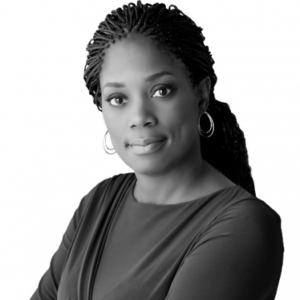
Photo Credit: Huffington Post http://www.huffingtonpost.com/antoine...
This story appeared as part of Pace e Bene/Campaign Nonviolence‘s inspirational email service: This Nonviolent Life. Sign up here.
On August 20, 2013, Antoinette Tuff (right) nonviolently disarmed a school shooter, saving the lives of hundreds of school children. Antoinette was a bookkeeper. She wasn’t supposed to be at the school that day. She was just filling in as a front desk receptionist as a favor to a friend. That morning, during her prayer time, she had read the Biblical line, “Yea, though I walk through the valley of the shadow of death, I shall fear no evil.” Little did she know that just a few hours later, twenty-year old Michael Brandon Hill walked onto the elementary school grounds in DeKalb County, Georgia, carrying an assault rifle and 500 rounds of ammunition.
The police had arrived, the school was on lockdown, Antoinette was alone in this part of the building. Michael Hill entered the room. Scared to her bones, she obeyed his initial commands, but then, for some reason, she asked, “May I go the bathroom?”
Those who have taken unarmed peacekeeping, peace team, or de-escalation training will recognize this phenomenon at once: she broke the script, changed the narrative, and distracted Michael Hill from continuing on a track of senseless rage and disconnect that frequently occurs with mass shooters. In this CNN interview about the events, Kris Wilder, a 30-year veteran of the martial arts and author of How to Win a Fight: A Guide to Avoiding and Surviving Violence, is quoted as saying that one way to stop a dangerous situation is to, “Change the channel with an out-of-the-blue question like, “What time is it?” or a nonsensical question like, “What was Gandhi’s batting average?”
To Antoinette Tuff’s surprise, it worked. Michael Hill agreed to let her go to the bathroom. She rose to leave, but suddenly realized that the shooter might follow her to where the children were hiding. She hesitated. Then the situation worsened. Hill propped open the front door of the school and began firing at the police outside.
Antoinette Tuff sprang into action. Gently, lovingly (and filled with a strange sense of calm) she said, “Sweetheart, come back in here. Bullets don’t have no names. And those bullets gonna kill me and you. I need you to come back in here and it’s gonna be you and me and we will work this thing out.”
Michael Hill retreated from the door, and Antoinette continued to talk, telling him about her marital troubles and how she contemplated suicide four times. As she spoke, she found herself meeting his eyes and connecting to him as a human being. To her amazement, Michael began to express his concerns and fears. Eventually, through dialogue and listening, empathizing, and connecting, Antoinette convinced him to lay down his gun, and surrender to the police.
Antoinette Tuff’s jaw-dropping story is an astounding example of engaged nonviolence in the height of a violent situation. It is interesting to note that Antoinette Tuff is a deeply spiritual person. She “meditated” for 15 minutes each day and connected with her spiritual practice each night. Regardless of whether you are Christian, Buddhist, Muslim, Hindu, Jewish, or some other faith, the practice of calming and centering the mind, grasping your inner strength, seeing with compassion, and rooting yourself in faith is an invaluable preparation for engaging active nonviolence in the world.
Learn more via the Metta Center’s exploration of how Antoinette Tuff used the power of active nonviolence: http://mettacenter.org/daily-metta/are-we-ignoring-the-lesson-of-nonviolence-daily-metta/
____________
A uthor/Activist Rivera Sun, syndicated by PeaceVoice, is the author of The Dandelion Insurrection, Billionaire Buddha and Steam Drills, Treadmills, and Shooting Stars, the cohost of Love (and Revolution) Radio, and the cofounder of the Love-In-Action Network. She is a trainer and social media coordinator for Campaign Nonviolence and Pace e Bene. Sun attended the James Lawson Institute on Strategic Nonviolent Resistance in 2014 and her essays on social justice movements appear in Truthout and Popular Resistance. www.riverasun.com
uthor/Activist Rivera Sun, syndicated by PeaceVoice, is the author of The Dandelion Insurrection, Billionaire Buddha and Steam Drills, Treadmills, and Shooting Stars, the cohost of Love (and Revolution) Radio, and the cofounder of the Love-In-Action Network. She is a trainer and social media coordinator for Campaign Nonviolence and Pace e Bene. Sun attended the James Lawson Institute on Strategic Nonviolent Resistance in 2014 and her essays on social justice movements appear in Truthout and Popular Resistance. www.riverasun.com
From the Desk of Rivera Sun
- Rivera Sun's profile
- 161 followers



